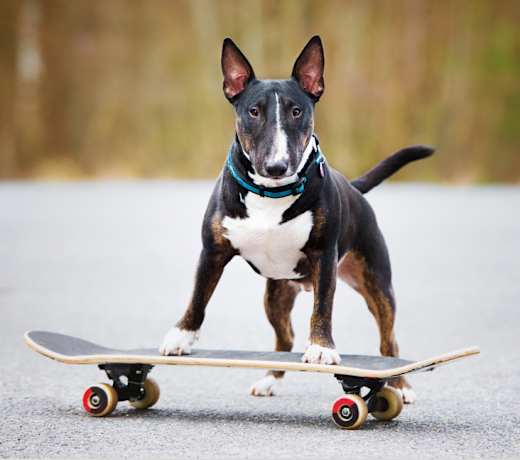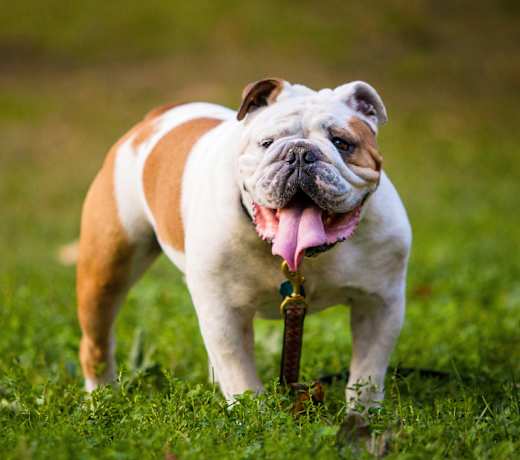American Staffordshire Terriers shed low to moderately throughout the year. However, during shedding seasons, which typically occur in the spring and fall, you may notice an uptick in shedding as they lose their old coat to make way for a new one. Regular grooming, such as brushing once a week, can help manage their shedding and keep their coat healthy during heavy shedding seasons.
American Staffordshire Terrier
Breed Type: Terrier
Common nicknames: Staffie, Amstaff
Coat: Smooth
Hypoallergenic: No, they will likely trigger allergies.
Temperament: Gentle, loyal, intelligent, independent
Life expectancy: 12-16 years
Color & patterns:

The American Staffordshire Terrier is a breed that often gets a bad rap, but those who know them understand they are truly fantastic dogs. These muscular pups typically weigh between 38 and 68 pounds and stand around 17 to 19 inches tall at the shoulder. Affectionately known as “AmStaffs” or “Staffies,” they are loyal, energetic, and love being around their humans. AmStaffs are often described as “nanny dogs” because of their natural tendency to watch over children and protect their families. They are also intelligent and trainable, making them excellent candidates for obedience competitions or simply learning new tricks. With proper socialization and training, they can coexist peacefully with other pets and even make great apartment dogs despite their size.
American Staffordshire Terrier characteristics
Learn about about American Staffordshire Terrier basics like their fur colors, shedding levels, how much grooming they need, and other American Staffordshire Terrier facts.
Average height
17-19 inches (43.2-48.3cm)
Average weight
38-68 pounds (17.2-30.8 kg)
Average lifespan
12-16 years
Exercise needs
Grooming needs
Full-grown size
Good with cats
Good with kids
Training aptitude
How big do American Staffordshire Terriers get?
American Staffordshire Terriers are medium to large-sized dogs who weigh between 40 and 70 pounds and stand around 17 to 19 inches tall.
What colors do American Staffordshire Terriers come in?
American Staffordshire Terriers come in a variety of colors, including solid colors such as black, blue, fawn, and red. They can also have various combinations of these colors with white markings, such as white patches on their chest or feet. Additionally, brindle patterns are common among American Staffordshire Terriers, where their base color is streaked or striped with another color, such as black or brown.
How many types of American Staffordshire Terriers are there?
There are three types of American Staffordshire Terrier: Bull, Terrier, and Moderate, a blend between the two.
American Staffordshire Terrier health
Learn about about the American Staffordshire Terrier health outlook and what diseases they may be prone to at various stages of their life.
Do you need to groom an American Staffordshire Terrier?
Yes, you need to groom an American Staffordshire Terrier by brushing them. This will help soothe the twice-yearly blowing of their coat. That’s about all the regular grooming you’ll need for this low-maintenance breed.
Do American Staffordshire Terriers have a lot of health problems?
The American Staffordshire Terrier is a very sturdy, generally healthy dog, but the breed is prone to some of the same issues that plague many other breeds. American Staffordshire Terriers, including:
Hip and/or elbow dysplasia: Hip and elbow dysplasia are two of the most common skeletal diseases seen in dogs. They are similar diseases in which either the hip or elbow joint has grown abnormally or is misshapen. The abnormal shape prevents the joints and sockets from properly meeting, resulting in rubbing and grinding instead of sliding smoothly. Unlike in hip dysplasia, where the main problem is joint instability, the abnormalities seen in elbow dysplasia often result in pieces of bone and/or cartilage breaking loose and irritating the joint tissues. Over time, the rubbing from dysplasia can cause a variety of issues, such as pain, lameness, and secondary osteoarthritis. Surgery can be done to fix the joint if diagnosed before the onset of arthritis. If you are rescuing an American Staffordshire terrier, have them checked out by a vet to see if they have or are prone to getting dysplasia so you know what they will be able to handle in terms of activities and exercise.
Patellar luxation: Also known as slipped kneecaps, patellar luxation is a common problem in many dog breeds. It occurs when slight abnormalities cause the knee joint to slide in and out of place and can cause pain and occasional lameness. Surgical treatment is available for severe cases although many dogs lead normal lives without treatment.
Cerebellar ataxia: Cerebellar ataxia is a neurological disease that affects a dog’s balance and coordination. The severity of symptoms ranges and can be as mild as a slightly odd gait or as severe as frequent falling and intense muscle tremors. Early detection and treatment are crucial for managing this condition, so it’s
important to be aware of the symptoms and seek veterinary care if you notice any.
Demodectic mange: This skin condition is caused by the demodex mite. All dogs are born with this tiny bug living in their hair follicles, and they do not generally cause problems. However, some immunocompromised dogs develop mange from the mite. Mange shows up on the skin as patches of red, thick scales and hair loss in the affected area.
Eye problems: Cataracts, a common eye condition that causes cloudiness in the eye and obstructs vision, and progressive retinal atrophy (PRA), a progressive degenerative disease affecting the retina that eventually leads to blindness.
Others: Hypothyroidism, a thyroid malfunction that results in low hormone production and could cause obesity, low energy, and a brittle coat; allergies; heart disease; and gastric dilatation-volvulus, a sudden, painful, and life-threatening swelling and twisting of the abdomen. To identify some of these issues, a veterinarian may recommend joint and screening tests for the dog.
American Staffordshire Terrier history
Learn about where the American Staffordshire Terrier came from.
Where are American Staffordshire Terriers from?
American Staffordshire Terriers are from the United States. While their ancestors can be traced back to England, AmStaffs developed from crosses between bulldogs and terriers in the early 19th century in the U.S., and eventually gained recognition as a distinct breed in the late 1800s. They were recognized as a separate breed in 1936.
American Staffordshire Terrier temperament
Learn about about the American Staffordshire Terrier temperament and how well they fit into your lifestyle, home environment, and family.
Are American Staffordshire Terriers good with kids?
Yes, American Staffordshire Terriers are good with kids so long as their pet parents properly socialize and train them and parents teach their children to treat dogs respectfully. This remarkably tolerant and gentle breed is best suited as a companion for older children. As with any breed, it is recommended that your child is always supervised when interacting with your American Staffordshire Terrier to keep both the child and dog safe.
Are American Staffordshire Terriers good family dogs?
Yes, American Staffordshire Terriers are good family dogs. They are incredibly devoted to, affectionate with, and protective of their humans. They do need adequate daily exercise and consistent training to make sure their behavior is in line.
Are American Staffordshire Terriers easy to train?
Yes, American Staffordshire Terriers can be easy to train. They are intelligent and eager to please, but they can also be strong-willed and independent, which might present some challenges during training. However, training any dog takes substantial time and effort, regardless of breed. Consistency, patience, and positive reinforcement methods are essential when training American Staffordshire Terriers.
How much do American Staffordshire Terriers bark?
The American Staffordshire Terrier will bark to alert but is not known to be an exceedingly vocal breed.
Are American Staffordshire Terriers good with cats?
Yes, American Staffordshire Terriers can be good with cats, but it largely depends on the individual dog’s temperament and upbringing. Some American Staffordshire Terriers may have a strong prey drive, which could lead to chasing behaviors towards smaller animals such as cats. However, many American Staffordshire Terriers can learn to coexist peacefully with cats with early socialization, proper training, and supervision.
Popular American Staffordshire Terrier mixes
Breeds that are commonly mixed with American Staffordshire Terriers include American Bulldogs, Boxers, and Labrador Retrievers. Characteristics of American Staffordshire Terrier mixes can vary widely depending on the specific breeds involved, the individual dog’s genetics, and its upbringing. A few common American Staffordshire Terrier mixes include:
American Bull Staffy (American Staffordshire Terrier + American Bulldog
Bullboxer Staff (American Staffordshire Terrier + Boxer)
Labrastaff (American Staffordshire Terrier + Labrador Retriever)
Amstiff (American Staffordshire Terrier + Mastiff)
English Bull Staffy (American Staffordshire Terrier + English Bulldog)
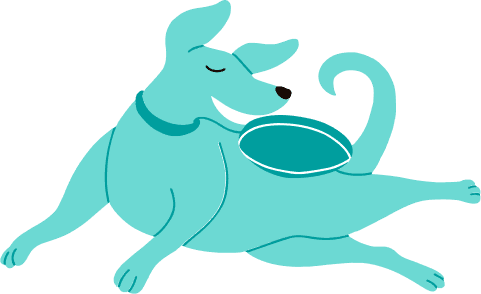
Find American Staffordshire Terrier puppies near you
Adopting an American Staffordshire Terrier
Learn about acquiring an American Staffordshire Terrier - the pros and cons of adopting versus going through a breeder, and associated costs.

Brady
American Staffordshire Terrier American Pit Bull Terrier
Male, 3 yrs 1 mo
Los Angeles, CA
Spayed or Neutered
Shots are up-to-date

Harley
American Staffordshire Terrier
Female, 7 yrs 8 mos
Los Angeles, CA
Good with dogs
Not good with cats
Needs experienced adopter
Spayed or Neutered
Shots are up-to-date
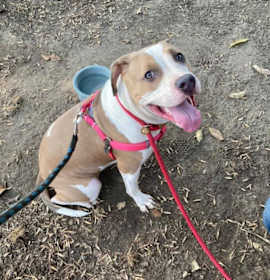
Ladybug
American Staffordshire Terrier
Female, 5 yrs 11 mos
Los Angeles, CA
Good with dogs
Not good with cats
Needs experienced adopter
Spayed or Neutered
Shots are up-to-date
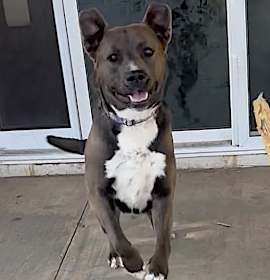
Whiskey
American Staffordshire Terrier
Male, 1 yr 10 mos
Los Angeles, CA
Good with cats
House-trained
Spayed or Neutered
Shots are up-to-date

Harlem
American Staffordshire Terrier
Male, 4 yrs
Los Angeles, CA
Good with dogs
House-trained
Spayed or Neutered
Shots are up-to-date

Flower
American Staffordshire Terrier American Pit Bull Terrier
Female, young
Beverly Hills, CA
Shots are up-to-date

Nectarine CP
American Staffordshire Terrier
Female, 1 yr 6 mos
Beverly Hills, CA
House-trained
Spayed or Neutered
Shots are up-to-date
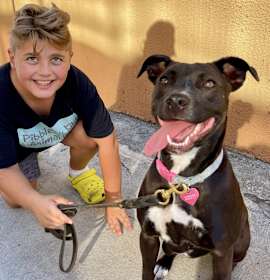
TURTLE
American Staffordshire Terrier Shepherd (Unknown Type)
Female, 2 yrs 8 mos
Studio City, CA
Good with dogs
Good with cats
House-trained
Spayed or Neutered
Shots are up-to-date

Brady
American Staffordshire Terrier American Pit Bull Terrier
Male, 3 yrs 1 mo
Los Angeles, CA
Spayed or Neutered
Shots are up-to-date

Harley
American Staffordshire Terrier
Female, 7 yrs 8 mos
Los Angeles, CA
Good with dogs
Not good with cats
Needs experienced adopter
Spayed or Neutered
Shots are up-to-date

Ladybug
American Staffordshire Terrier
Female, 5 yrs 11 mos
Los Angeles, CA
Good with dogs
Not good with cats
Needs experienced adopter
Spayed or Neutered
Shots are up-to-date

Whiskey
American Staffordshire Terrier
Male, 1 yr 10 mos
Los Angeles, CA
Good with cats
House-trained
Spayed or Neutered
Shots are up-to-date

Harlem
American Staffordshire Terrier
Male, 4 yrs
Los Angeles, CA
Good with dogs
House-trained
Spayed or Neutered
Shots are up-to-date

Flower
American Staffordshire Terrier American Pit Bull Terrier
Female, young
Beverly Hills, CA
Shots are up-to-date


